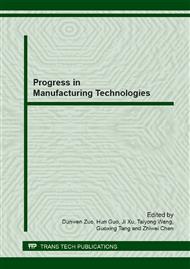[1]
Y.L. Fu. Just-In-Time Financial Controlling Mechanism: Its Meaning, Characteristics and Structure. Journal of Xiamen University(Arts & Social Sciences), 2(2003).
Google Scholar
[2]
Jr. Tom K. Massey. Scanning method controls competition and advises when new strategy is needed. Marketing News, 20, (1986)10.
Google Scholar
[3]
D. Shell, Integrate to select audience, develop strategy, control communications. Advertising Age's Business Marketing, 83, (1998)13.
Google Scholar
[4]
E. Sirois, S. Brothwell. International Trade: Strategy Needed to Better Control and Enforce Trade Agreements. DIANE Publishing, (2000).
Google Scholar
[5]
J.R. Qian, S.S. Qian, X.D. Huang . Corporate Strategy Information Controling and Alarming System. Industrial Engineering Journal, 4(2000).
Google Scholar
[6]
X.T. Sun, S.Y. Peng. Research about Financial Controling Mechanism based on Corporate Governance. Communication of Finance and Accounting(Academy Version), 7(2007).
Google Scholar
[7]
Y. Dong, B.Y. Li. To Analyse on Controling Mechanisms for the Listed Companies. Value Engineering, 6(2008).
Google Scholar
[8]
D. Dhar, Theoretical studies of self-organized criticality. Physica A, 369, (2006)29-70.
Google Scholar
[9]
Shen Xiao-feng, Zhang Li, Song Yong. On the self-organizing system evolution [J]. Journal of Beijing Normal University, 1993(03).
Google Scholar
[10]
W. Greinet,L. Neise. Thermodynamics and statistical mechanics , (2001).
Google Scholar
[11]
P.Y. Ren, L. Zhang and Y. Song. Based on the complexity science, management entropy and management dissipative structure theory and its role in the business organization and decision-making. Management World, 6(2001).
Google Scholar
[12]
P.Y. Ren. Recycling the organization's strategic decision on the management efficiency. Reform of Economic System, 3(1998).
Google Scholar
[13]
S. Kumara, P. Ranjan, A. Surana, et al. Decision making in logistics: a chaos theory based analysis. CIRP Annals-Manufacturing Technology, 52, (2003)381-384.
DOI: 10.1016/s0007-8506(07)60606-4
Google Scholar
[14]
C. Capelo, J. F. Dias. A feedback learning and mental models perspective on strategic decision making. Educational Technology Research and Development, 57, (2009)629-644.
DOI: 10.1007/s11423-009-9123-z
Google Scholar
[15]
A. Serletis, A. Shahmoradi. Chaos, self-organized criticality, and SETAR nonlinearity: An analysis of purchasing power parity between Canada and the United States. Chaos, Solitons & Fractals, 33, (2007)1437-1444.
DOI: 10.1016/j.chaos.2006.02.008
Google Scholar
[16]
E. Trovato, P. Castagliola, G. Celano, et al. Economic design of inspection strategies to control dispersion in short production runs. Computers & Industrial Engineering, 59, (2010)87-897.
DOI: 10.1016/j.cie.2010.08.019
Google Scholar
[17]
C. Tetzlaff, S. Okujeni, U. Egert, et al. Self-Organized Criticality in Developing Neuronal Networks. PLoS Computational Biology, 6, (2010)1-18.
DOI: 10.1371/journal.pcbi.1001013
Google Scholar
[18]
Y.J. Zhang. Research on Strategic Coordination Mechanism of Adaptive Corporate . Harbin Engineering University, Harbin (2010).
Google Scholar
[19]
W. Wang. Prediction of CPI Price Index Based on Chaotic Neural Networks. Statistics and Decision, 10(2012).
Google Scholar
[20]
X.F. Li, E. Zhou and L.H. Zhou. Chaos BP hybrid learning algorithm for feedforward neural network. Control and Decision, 4(2004).
Google Scholar
[21]
J.M. Xia D.R. Xiao. Chaotic time series prediction model based on the Lyapunov exponent and CBP. Statistics and Decision, 16(2007).
Google Scholar


